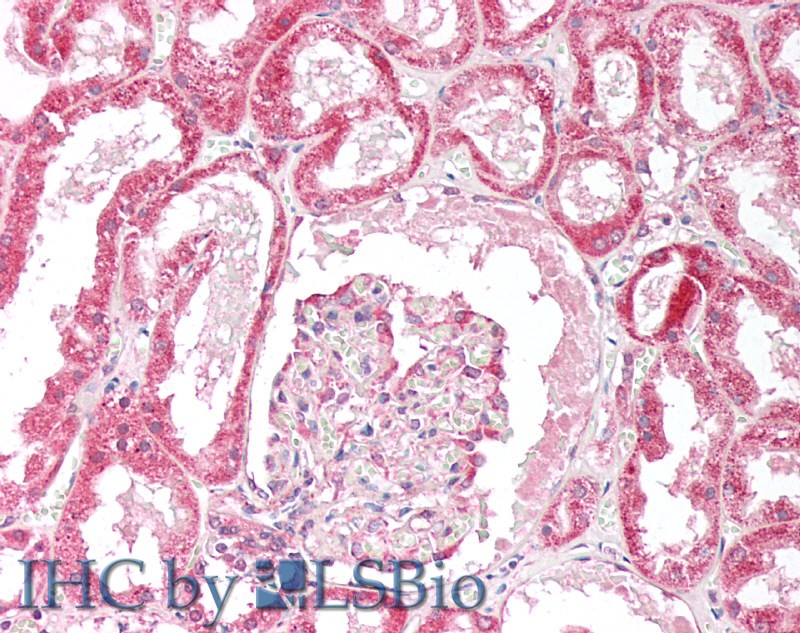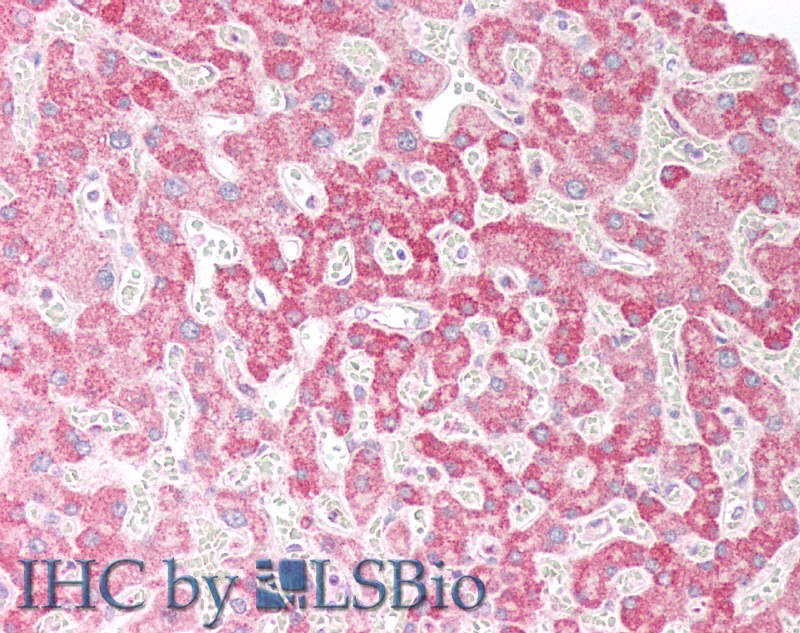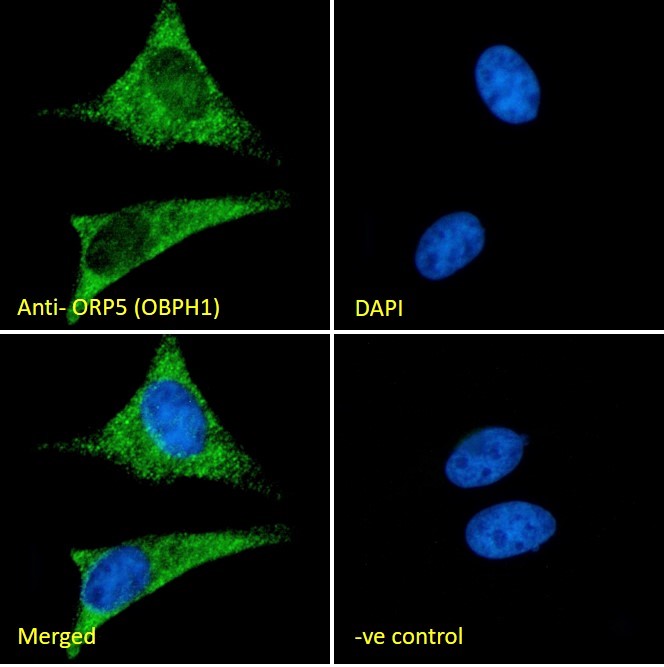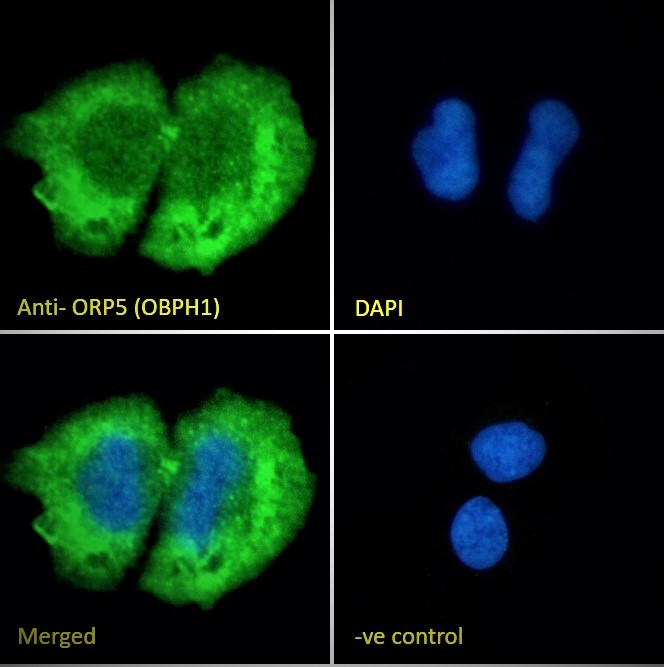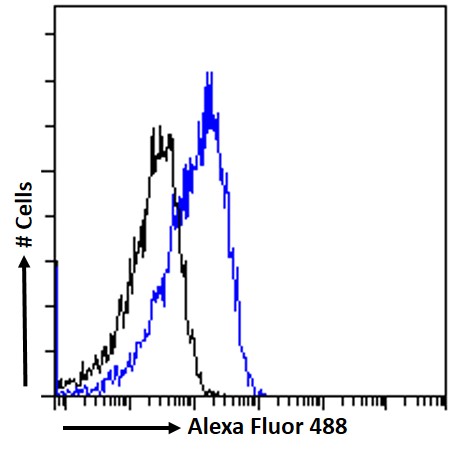Goat Anti-ORP5 (OBPH1) Antibody
Peptide-affinity purified goat antibody
- SPECIFICATION
- CITATIONS
- PROTOCOLS
- BACKGROUND

Application
| WB, E |
|---|---|
| Primary Accession | Q9H0X9 |
| Other Accession | NP_001137535, 114879, 79196 (mouse) |
| Reactivity | Human |
| Predicted | Mouse, Rat, Dog |
| Host | Goat |
| Clonality | Polyclonal |
| Concentration | 100ug/200ul |
| Isotype | IgG |
| Calculated MW | 98616 Da |
| Gene ID | 114879 |
|---|---|
| Other Names | Oxysterol-binding protein-related protein 5, ORP-5, OSBP-related protein 5, Oxysterol-binding protein homolog 1, OSBPL5, KIAA1534, OBPH1, ORP5 |
| Format | 0.5 mg IgG/ml in Tris saline (20mM Tris pH7.3, 150mM NaCl), 0.02% sodium azide, with 0.5% bovine serum albumin |
| Storage | Maintain refrigerated at 2-8°C for up to 6 months. For long term storage store at -20°C in small aliquots to prevent freeze-thaw cycles. |
| Precautions | Goat Anti-ORP5 (OBPH1) Antibody is for research use only and not for use in diagnostic or therapeutic procedures. |
| Name | OSBPL5 |
|---|---|
| Synonyms | KIAA1534, OBPH1 {ECO:0000303|PubMed:1250 |
| Function | Lipid transporter involved in lipid countertransport between the endoplasmic reticulum and the plasma membrane: specifically exchanges phosphatidylserine with phosphatidylinositol 4-phosphate (PI4P), delivering phosphatidylserine to the plasma membrane in exchange for PI4P, which is degraded by the SAC1/SACM1L phosphatase in the endoplasmic reticulum. Binds phosphatidylserine and PI4P in a mutually exclusive manner (PubMed:23934110, PubMed:26206935). May cooperate with NPC1 to mediate the exit of cholesterol from endosomes/lysosomes (PubMed:21220512). Binds 25-hydroxycholesterol and cholesterol (PubMed:17428193). |
| Cellular Location | Endoplasmic reticulum membrane; Single-pass membrane protein. Note=Localizes to endoplasmic reticulum-plasma membrane contact sites (EPCS). Localizes to the cortical endoplasmic reticulum at the EPCS |
| Tissue Location | Ubiquitously expressed. |

Thousands of laboratories across the world have published research that depended on the performance of antibodies from Abcepta to advance their research. Check out links to articles that cite our products in major peer-reviewed journals, organized by research category.
info@abcepta.com, and receive a free "I Love Antibodies" mug.
Provided below are standard protocols that you may find useful for product applications.
Background
This gene encodes a member of the oxysterol-binding protein (OSBP) family, a group of intracellular lipid receptors. Most members contain an N-terminal pleckstrin homology domain and a highly conserved C-terminal OSBP-like sterol-binding domain. Transcript variants encoding different isoforms have been identified.
References
Genome-wide association study of alcohol dependence implicates a region on chromosome 11. Edenberg HJ, et al. Alcohol Clin Exp Res, 2010 May. PMID 20201924.
Oxysterol binding protein-related protein-5 is related to invasion and poor prognosis in pancreatic cancer. Koga Y, et al. Cancer Sci, 2008 Dec. PMID 19032366.
Proteomic analysis reveals Hrs ubiquitin-interacting motif-mediated ubiquitin signaling in multiple cellular processes. Pridgeon JW, et al. FEBS J, 2009 Jan. PMID 19019082.
Systematic identification of SH3 domain-mediated human protein-protein interactions by peptide array target screening. Wu C, et al. Proteomics, 2007 Jun. PMID 17474147.
Global, in vivo, and site-specific phosphorylation dynamics in signaling networks. Olsen JV, et al. Cell, 2006 Nov 3. PMID 17081983.
If you have used an Abcepta product and would like to share how it has performed, please click on the "Submit Review" button and provide the requested information. Our staff will examine and post your review and contact you if needed.
If you have any additional inquiries please email technical services at tech@abcepta.com.













 Foundational characteristics of cancer include proliferation, angiogenesis, migration, evasion of apoptosis, and cellular immortality. Find key markers for these cellular processes and antibodies to detect them.
Foundational characteristics of cancer include proliferation, angiogenesis, migration, evasion of apoptosis, and cellular immortality. Find key markers for these cellular processes and antibodies to detect them. The SUMOplot™ Analysis Program predicts and scores sumoylation sites in your protein. SUMOylation is a post-translational modification involved in various cellular processes, such as nuclear-cytosolic transport, transcriptional regulation, apoptosis, protein stability, response to stress, and progression through the cell cycle.
The SUMOplot™ Analysis Program predicts and scores sumoylation sites in your protein. SUMOylation is a post-translational modification involved in various cellular processes, such as nuclear-cytosolic transport, transcriptional regulation, apoptosis, protein stability, response to stress, and progression through the cell cycle. The Autophagy Receptor Motif Plotter predicts and scores autophagy receptor binding sites in your protein. Identifying proteins connected to this pathway is critical to understanding the role of autophagy in physiological as well as pathological processes such as development, differentiation, neurodegenerative diseases, stress, infection, and cancer.
The Autophagy Receptor Motif Plotter predicts and scores autophagy receptor binding sites in your protein. Identifying proteins connected to this pathway is critical to understanding the role of autophagy in physiological as well as pathological processes such as development, differentiation, neurodegenerative diseases, stress, infection, and cancer.

